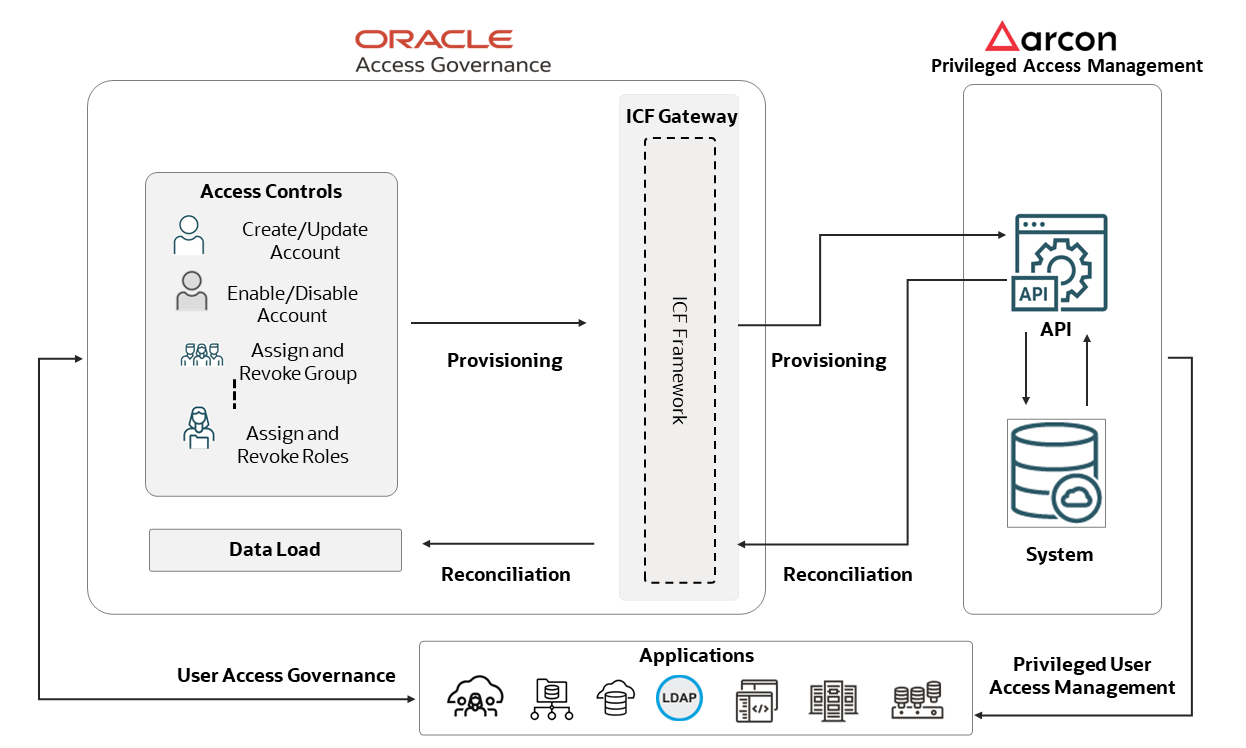Imagine a scenario where a global financial institution faces constant security threats, both internal and external. Their IT infrastructure is massive, and privileged accounts, which are often the gateway to critical systems, are spread across multiple departments. Each privileged account holds the power to access sensitive data and perform high-level operations, making them prime targets for cybercriminals and malicious insiders. For this organization, managing and securing privileged accounts is no longer just an operational need, but a crucial part of its risk management strategy.
Here, the integration of Arcon Privileged Access Management (PAM) with Oracle Access Governance comes into play. This solution is designed to protect privileged accounts while helping ensure that access management adheres to governance policies and compliance requirements. This integration isn’t limited to financial institutions but can be applied across any industry vertical and any geographic locations.
In this blog, we explore how the integration of Arcon PAM with Oracle Access Governance helps businesses strengthen their security posture and streamline access management.
The challenges of managing privileged accounts
Privileged accounts are high-value targets because they can access the most critical systems in an organization. These accounts typically belong to system administrators, database managers, and other high-level users who perform sensitive operations. Compromise of these accounts can lead to devastating breaches, data leaks, or unauthorized changes to critical systems. Organizations must also ensure compliance with strict regulatory requirements like GDPR, SOX, and HIPAA, which demand rigorous tracking and management of privileged access.
In the case of our example financial institution, they realized that their traditional methods of managing privileged access—using spreadsheets and manual processes—weren’t scalable or secure enough. They needed a way to not only control privileged access but also govern and monitor it continuously.
Arcon PAM and Oracle Access Governance
Arcon PAM is designed to secure, control, and monitor privileged accounts. It provides a comprehensive solution for managing privileged access across various IT environments, helping ensure that only authorized users can access critical systems. However, while Arcon PAM provides robust security, managing privileged access at scale also requires a governance layer to automate processes and support compliance with regulatory standards. This is where Access Governance comes into play.
When Arcon PAM is integrated with Oracle Access Governance, the benefits go beyond controlling privileged access. The integration automates governance processes, streamlines access reviews, enforces security policies, and helps ensure that privileged access aligns with the organization’s compliance and risk management objectives.

Key benefits of Arcon PAM and Oracle Access Governance integration
The integration of these two services offers the following features and benefits:
- Centralized access control: In financial institutions for example, IT administrators struggled to manage hundreds of privileged accounts manually. The integration of Arcon PAM with Oracle Access Governance offers a centralized platform for managing and controlling these accounts. IT teams can create consistent access policies across all systems, helping ensure that privileged users are granted the only access they need.
- Automated access reviews and certifications: Manual access reviews are labor-intensive and prone to human error. With the integration of Arcon PAM and Oracle Access Governance, the institution can automate access review and certification processes. The system regularly checks who has access to privileged accounts, whether it’s still necessary, and whether any adjustments are needed. This setup helps ensure compliance with industry regulations and internal security policies.
- Enhanced security through multifactor authentication (MFA): A key feature of Arcon PAM is the use of MFA to secure privileged access. When integrated with Oracle Access Governance, the financial institution can enforce MFA policies consistently across all privileged accounts across multiple applications. This enforcement helps ensure that, even if login credentials are compromised, unauthorized access is prevented by requiring additional verification for every single application.
- Real-time monitoring and reporting: The integration provides real-time visibility into how privileged accounts are being used. The enterprise can monitor user activity, detect unusual behavior, and generate detailed audit logs for compliance and reporting purposes. This level of visibility is crucial for identifying potential security threats before they escalate into major incidents.
A closer look at the integration
The agent-based integration of Arcon PAM with Oracle Access Governance works seamlessly to provide end-to-end security for privileged accounts with the following key components:
- Identity lifecycle management: Oracle Access Governance automates the onboarding and offboarding of privileged users. When a new admin joins, they’re automatically provisioned with the necessary access based on predefined roles. When they leave, their access is immediately revoked, reducing the risk of orphaned accounts.
- Role-based access control (RBAC): The integration uses RBAC to help ensure that users are granted access based on their roles and responsibilities. This system helps eliminate the risk of excessive privileges by allowing users to perform only actions relevant to their duties.
- Audit and compliance reporting: With automated access certifications, audit logs, and real-time monitoring, the integration provides the institution with the tools needed to maintain compliance and demonstrate control over privileged accounts during audits.
Conclusion
The integration of Arcon PAM with Oracle Access Governance is more than just a solution. It’s a strategic enabler of security and compliance. It allows businesses to centralize and automate the management of privileged accounts, reducing risks and helping ensure that access policies align with governance standards.
As cyber threats continue to evolve and regulations become more stringent, securing privileged access is no longer optional. The integration of Arcon PAM with Oracle Access Governance provides the necessary tools to help you safeguard sensitive systems, maintain compliance, and protect against insider threats. This comprehensive approach not only helps safeguard sensitive systems but also positions organizations to thrive in an increasingly complex and regulatory-driven world.
To learn more about Oracle Access Governance and available integrations, see the following resources:

